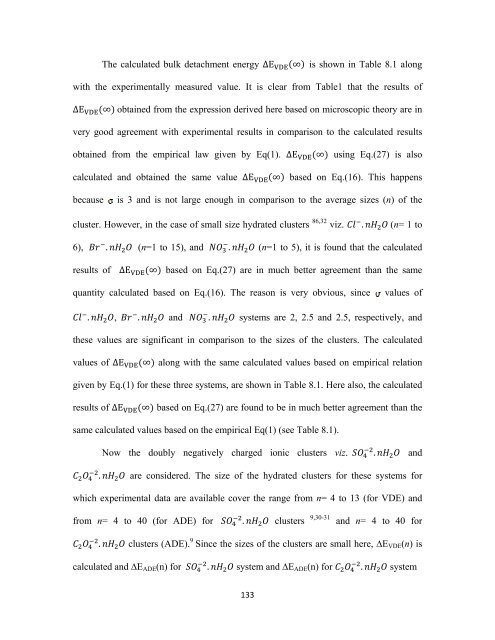CHEM01200604005 A. K. Pathak - Homi Bhabha National Institute
CHEM01200604005 A. K. Pathak - Homi Bhabha National Institute
CHEM01200604005 A. K. Pathak - Homi Bhabha National Institute
Create successful ePaper yourself
Turn your PDF publications into a flip-book with our unique Google optimized e-Paper software.
The calculated bulk detachment energy ∆E DE ∞ is shown in Table 8.1 along<br />
with the experimentally measured value. It is clear from Table1 that the results of<br />
∆E DE ∞ obtained from the expression derived here based on microscopic theory are in<br />
very good agreement with experimental results in comparison to the calculated results<br />
obtained from the empirical law given by Eq(1). ∆E DE ∞ using Eq.(27) is also<br />
calculated and obtained the same value ∆E DE ∞ based on Eq.(16). This happens<br />
because<br />
is 3 and is not large enough in comparison to the average sizes (n) of the<br />
cluster. However, in the case of small size hydrated clusters 86,32 viz. . (n= 1 to<br />
6), . (n=1 to 15), and . (n=1 to 5), it is found that the calculated<br />
results of ∆E DE ∞ based on Eq.(27) are in much better agreement than the same<br />
quantity calculated based on Eq.(16). The reason is very obvious, since<br />
values of<br />
. , . and . systems are 2, 2.5 and 2.5, respectively, and<br />
these values are significant in comparison to the sizes of the clusters. The calculated<br />
values of ∆E DE ∞ along with the same calculated values based on empirical relation<br />
given by Eq.(1) for these three systems, are shown in Table 8.1. Here also, the calculated<br />
results of ∆E DE ∞ based on Eq.(27) are found to be in much better agreement than the<br />
same calculated values based on the empirical Eq(1) (see Table 8.1).<br />
Now the doubly negatively charged ionic clusters viz. . and<br />
. are considered. The size of the hydrated clusters for these systems for<br />
which experimental data are available cover the range from n= 4 to 13 (for VDE) and<br />
from n= 4 to 40 (for ADE) for . clusters 9,30-31<br />
and n= 4 to 40 for<br />
. clusters (ADE). 9 Since the sizes of the clusters are small here, ∆E VDE (n) is<br />
calculated and ∆E ADE (n) for . system and ∆E ADE (n) for . system<br />
133
















